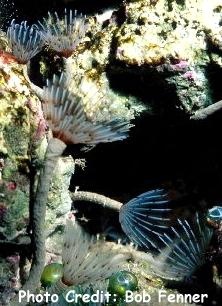
By Bob Goemans


Likely Reef Tank Suitable
Likely Fish-Only Tank Suitable
Commonly called Feather Dusters and in the Order Sabellida, these worms construct a leathery tube sometimes up to 12 inches (30 cm) in length from which they extend a single crown of multicolored feather-like filaments. In the wild, they are usually found buried in sand, not adhered to rocks. Their tubes are constructed of sand, detritus, mucus, and other bits of sediment. It is better to locate these worms near the bottom of the aquarium where this material is more plentiful. The fact that particulate matter is higher near the bottom of the aquarium and that they are not photosynthetic animals, are other good reasons to place them in this area.
They use their slime-coated filaments/tentacles or "feathers" as some call them, for respiration and to collect suspended particulate matter/plankton. The collected matter is then drawn towards the mouth area at the center of the tentacle ring. Solutions containing phytoplankton and/or zooplankton (rotifers) are recommended. These feeding solutions should be applied near and under the crown of feathers so it can normally be drawn up and to the beating cilia on the feathers. It should be noted these tiny hair-like extensions generate the current that draws the food supply into the feather-like head of the animal. Dispensing the feeding solution above the animal may cause the animal to retract with most of the feeding solution going to waste.
Feather dusters may lose their crown of "feathers" for many reasons, some being: poor water quality; being disturbed too often; or, lack of a sufficient amount of food. This does not mean they are dead, as most will grow their feathers back in a month or so. If the head returns and is smaller, this is an indication the food supply is inadequate. Could be if this happens again and the head comes back again smaller, the tubeworm will die. Always wait a couple of months and if no reappearance occurs, feel the tube for the worm body inside. If there is some movement inside the tube, put it back and be patient for another month.
When it comes to keeping any of the ornamental type worms, predators like triggerfish, wrasses, angelfish, most shrimp, and the arrow crab will not make suitable tankmates.